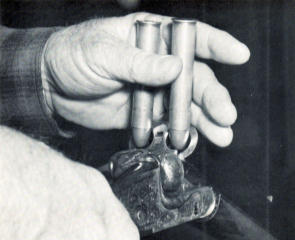| DUGABOY1 |
| (.400 member) |
| 18/04/04 02:01 AM |

|
|
|
Actually the weakest action type, as far as flex goes is the BAR ACTION SIDE LOCK! The action bar is relieved heavily for the bar action. It not only is relieved for the nose of the side lock plate, but the spring behand it, as well as the cocking levers, and sliding Purdy locking bar. The box lock has only the cuts for the cocking levers,and the slideing bar for engageing the bites in the lumps lock in the bars, the tumblers, sears, and springs are in the back of the action. If you look at the side of the A&D boxlock action from the side, you will see two pins at the back of the action , near the wood, and below the thickest part of the action below the fences (standing breach). For this reason the bar can be made shorter, to reduce the leverage between the henge pin, and the face, to apply leverage to bend the bar down. The longer the bar is from face to henge pin,the thicker it has to be, and the more need for a third fastener such as a well fitted doll's head, to retard forward movement, or opening of the action, by bending of the bar. The bar of the A&D boxlock, has far less steel removed from the bar, than the Bar Action side lock. Additionally, both types of sidelocks ( bar action, and Back action) require the removal of a lot of wood, in the weakest part of the stock, in the wrist. The wood is far more likely to fail than the action it's self. The main reason the side lock is considered to be stronger, by most people, is because they cost more to make,and so they are always the more expensive rifle of a maker. Check out the link below! Scroll down to "ACTION"

http://hallowellco.com/abbrevia.htm